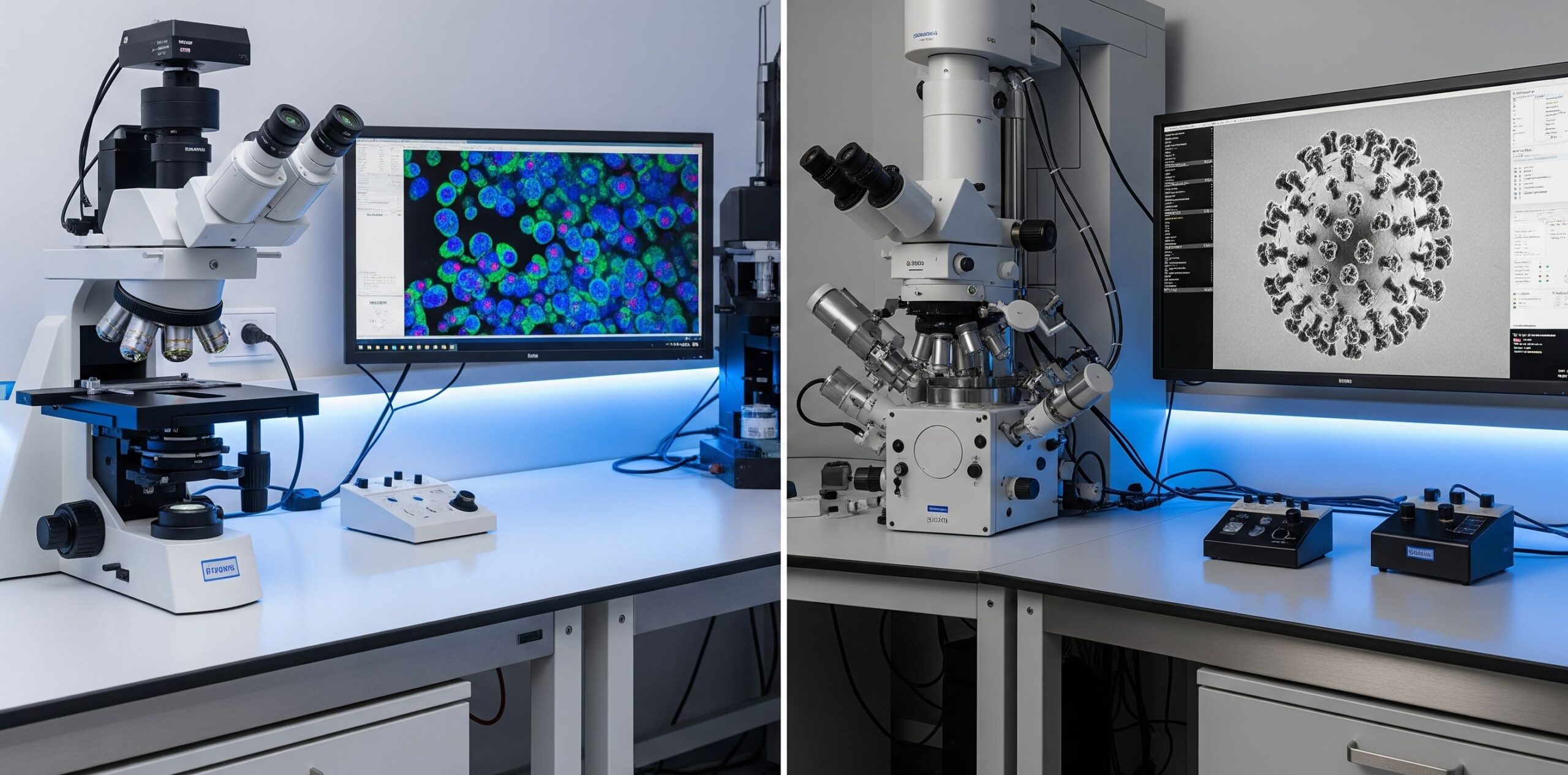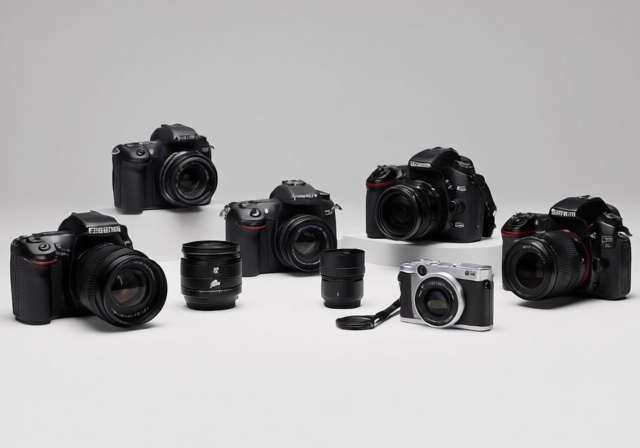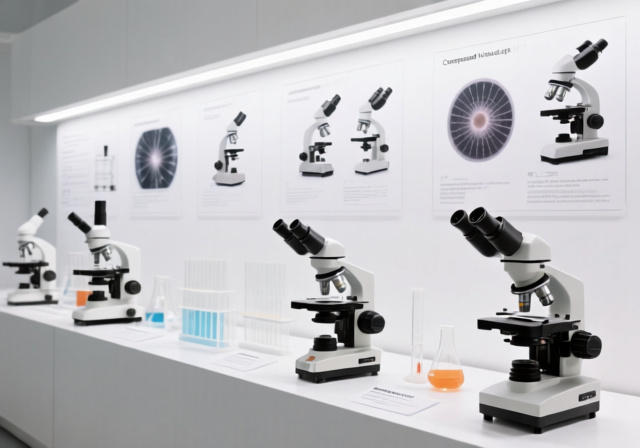



Understanding the fundamental differences between light microscopes and electron microscopes is crucial for photographers, researchers, and students working in scientific photography. While light microscopes use visible light to magnify images of specimens, electron microscopes utilize a beam of electrons for magnification, creating vastly different imaging capabilities and applications. Whether you’re documenting cellular structures for educational materials or capturing intricate details of microscopic specimens, choosing the right microscope directly impacts your photographic results and research outcomes.
| Feature | Light Microscope | Electron Microscope |
|---|---|---|
| Magnification | Up to 1,500x-2,000x | Up to 1,000,000x |
| Resolution | Limited to ~200nm | Sub-nanometer (250x better) |
| Specimen Type | Living or dead | Dead/fixed only |
| Image Color | Full color | Black and white |
| Cost | $500-$5,000 | $50,000-$1,000,000+ |
| 3D Capability | Limited (stereo microscopes) | SEM provides 3D surface images |
A light microscope is a type of microscope that uses visible light (400-700nm wavelength) to magnify the image of a specimen. For photographers documenting scientific subjects, light microscopes offer several distinct advantages that make them ideal for capturing living organisms and colorful biological specimens.
The optical system works by passing light through or reflecting it off a specimen, then using glass lenses to magnify the resulting image. Light microscopes are lightweight, easy to use, and don’t require a vacuum environment, making them ideal for quick and routine observations. This accessibility makes them perfect for photographers who need to capture images in various settings, from field work to studio environments.
One big advantage of light microscopes is the ability to observe living cells. For scientific photographers, this means capturing dynamic processes in real-time – cell division, bacterial movement, or the uptake of nutrients. The ability to use various colored stains and dyes creates visually striking images that are both scientifically accurate and aesthetically appealing.
Light microscopes also allow for relatively simple camera attachments. Most modern light microscopes can be fitted with DSLR or mirrorless camera adapters, enabling high-quality photomicrography without extensive modifications. The real-time viewing capability means photographers can compose shots effectively and adjust lighting conditions on the fly.
Electron microscopy (EM) is a technique for obtaining high resolution images using electrons as the source of illuminating radiation. Invented in 1931 by Ernst Ruska and Max Knoll, electron microscopes operate on an entirely different principle than light microscopes.
Instead of using photons, electron microscopes use a beam of accelerated electrons focused by electromagnetic or electrostatic lenses. Operating at 200 keV, an electron microscope’s illumination source has a wavelength of roughly 2.5 picometers, enabling visualization of structures impossible to see with light microscopes.
Electron microscope images present unique challenges and opportunities for photographers. Specimens must be fixed, dehydrated, and coated with heavy metals to reflect electrons. This preparation process, while labor-intensive, creates incredibly detailed images revealing structures at the nanometer scale.
The images produced are inherently monochromatic, requiring post-processing for colorization. Modern electron microscopes use specialized digital cameras and frame grabbers to capture images, with software enabling false-color additions to highlight different structures or materials.
Electron microscopes offer far superior resolution, achieving magnification up to 1,000,000x and sub-nanometer resolution about 250 times that of conventional light microscopes. This dramatic difference means electron microscopes can reveal: – Virus structures (30-250nm) – Individual proteins (10nm) – DNA double helix (2nm) – Atomic arrangements in crystals
For photographers, this translates to entirely different imaging scales. While light microscopes excel at capturing whole cells and tissue structures with natural colors, electron microscopes reveal the intricate architecture within these structures in unprecedented detail.
Compared to electron microscopy, light microscopy offers simpler specimen preparation – you can use living or dead specimens, fixed or unfixed, stained or unstained. This flexibility allows photographers to: – Document living processes in real-time – Use multiple fluorescent stains simultaneously – Quickly switch between specimens – Maintain natural colors and structures
Electron microscopy requires extensive preparation that fundamentally alters specimens. Preparing specimens for electron microscopy is labor-intensive and requires high skill levels, often taking several days to complete. Photographers must account for: – Complete dehydration requirements – Metal coating procedures – Ultra-thin sectioning (0.1 micrometers or less) – Vacuum chamber constraints
In scanning electron microscopy (SEM), due to the nature of electrons, electron microscopes have a greater depth of field compared to light microscopes. This enhanced depth of field creates striking 3D-like images of surface structures, making SEM particularly valuable for: – Material science photography – Biological surface structures – Industrial quality control imaging – Forensic documentation
Light microscopes are ideal for photographers when: – Documenting living organisms or dynamic processes – Natural color is essential for accurate representation – Working with specimens larger than 200nm – Budget constraints exist ($500-$5,000 typical range) – Portability is required for field work – Quick turnaround is needed for images
Electron microscopes become necessary when: – Resolving structures smaller than 200nm – Documenting viral particles or molecular structures – Creating detailed surface topology images – Research requires publication-quality ultrastructure images – Budget allows for facility access or equipment purchase – Black and white images are acceptable
For students studying microscopy at the GCSE level, understanding these key differences is essential. Light microscopes have a magnification power of up to x2000 and use beams of light and lenses to magnify living objects. They’re the primary tool in school laboratories because they’re: – Affordable and portable – Safe for student use – Capable of viewing living specimens – Suitable for basic cell structure observation
Electron microscopes have allowed us to get a better understanding of sub-cellular structures, as they have greater magnification capacity, higher resolution and greater resolving power compared to light microscopes. However, their complexity and cost limit them to specialized research facilities.
The field of microscopy continues to evolve with new technologies bridging the gap between light and electron microscopy. Super-resolution light microscopy techniques like STED (Stimulated Emission Depletion) and MINFLUX are pushing the boundaries of what’s possible with light-based systems, achieving resolutions approaching those of electron microscopes while maintaining the ability to image living specimens.
For photographers, these advances mean: – Increased resolution without sacrificing color or live imaging – New creative possibilities for scientific visualization – More accessible high-resolution imaging options – Integration with AI for automated image enhancement
No, electron microscopes cannot observe living cells. The specimen must be prepared in a vacuum chamber and treated with heavy metals, which kills any living organisms. Only light microscopes can observe living specimens in real-time.
Electron microscopes detect electrons rather than visible light, so they cannot capture color information. The images show variations in electron density as shades of grey. Scientists often add false colors to these images to highlight different structures.
Light microscopes are ideal for GCSE biology because they’re accessible, easy to use, and allow students to observe living organisms and perform real-time experiments. Students can prepare their own slides and see cells, bacteria, and tissues in their natural colors.
Electron microscopes can achieve magnifications up to 1,000,000x compared to a light microscope’s maximum of about 1,500x. This means electron microscopes are roughly 650 times more powerful in terms of magnification, with resolution capabilities about 1000 times better.
The choice between light microscope vs electron microscope ultimately depends on your specific photographic goals and subject matter. Generally, optical and electron microscopes have different areas of application and they complement each other. Light microscopes remain the workhorses of biological imaging, offering color, convenience, and the ability to capture life in action. Electron microscopes provide unparalleled detail for those seeking to document the nanoscale world, despite their limitations in specimen preparation and monochromatic output.
For most photographers entering scientific imaging, starting with a quality light microscope provides the best foundation. As your work demands higher resolution or specific applications require electron microscopy, collaboration with research facilities can provide access to these powerful tools. Remember that the best microscope is the one that allows you to capture the images you need for your specific application – whether that’s documenting living cells in vibrant color or revealing the intricate ultrastructure of materials at the nanoscale.







